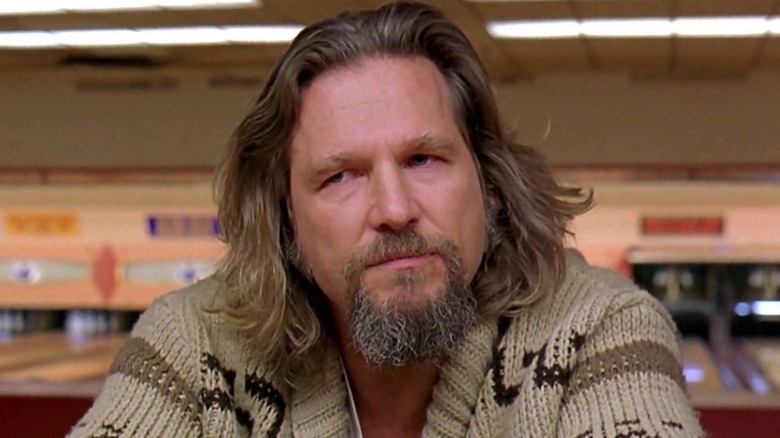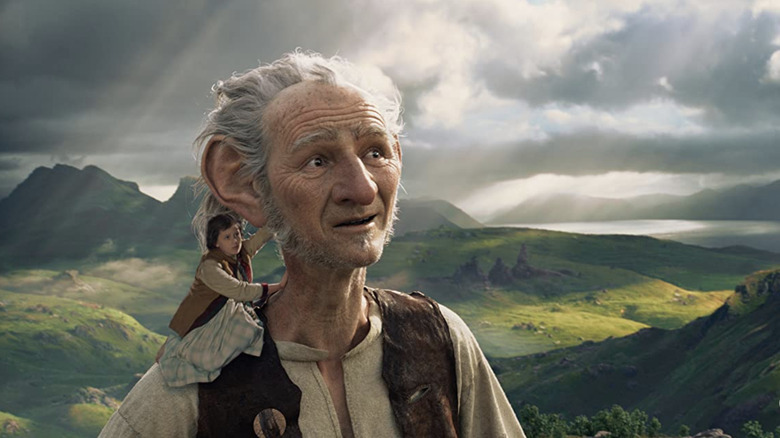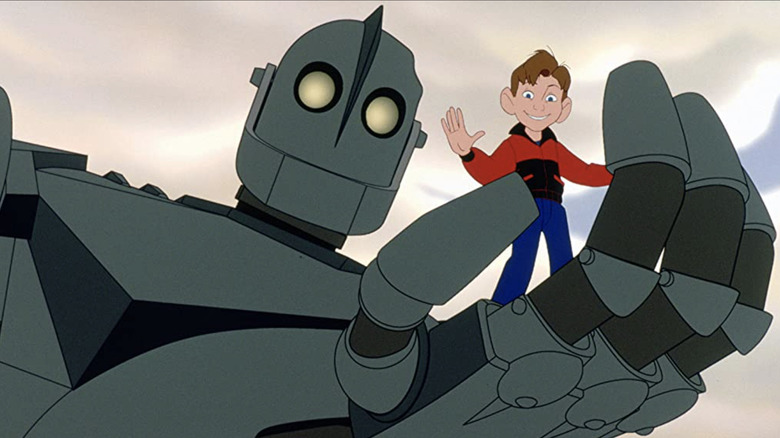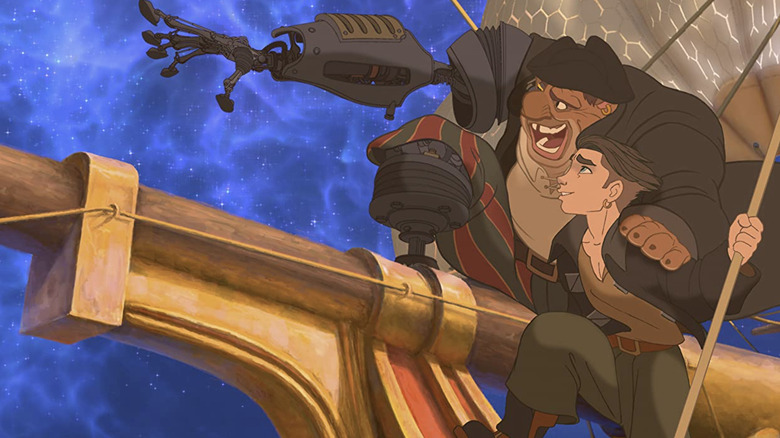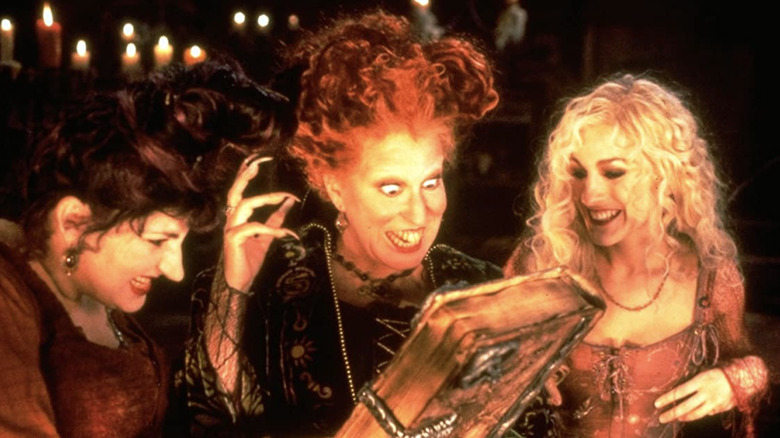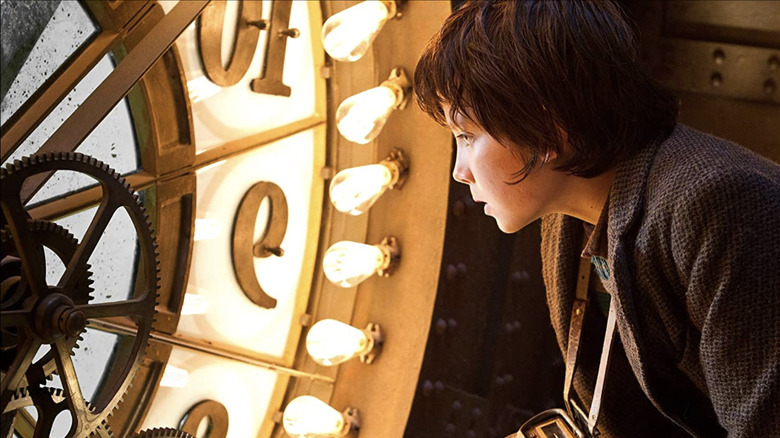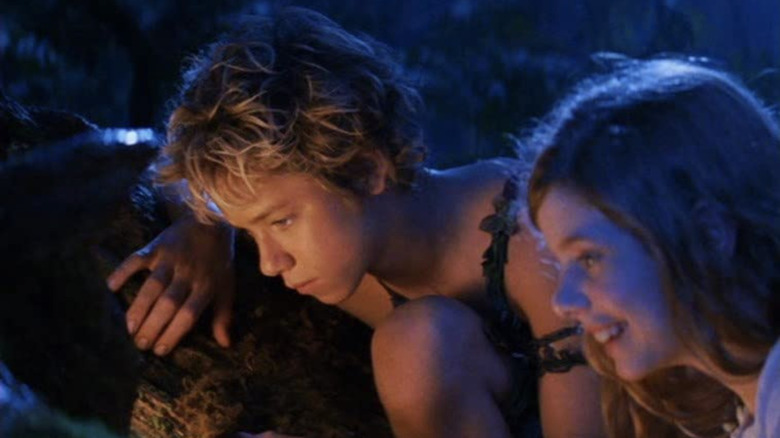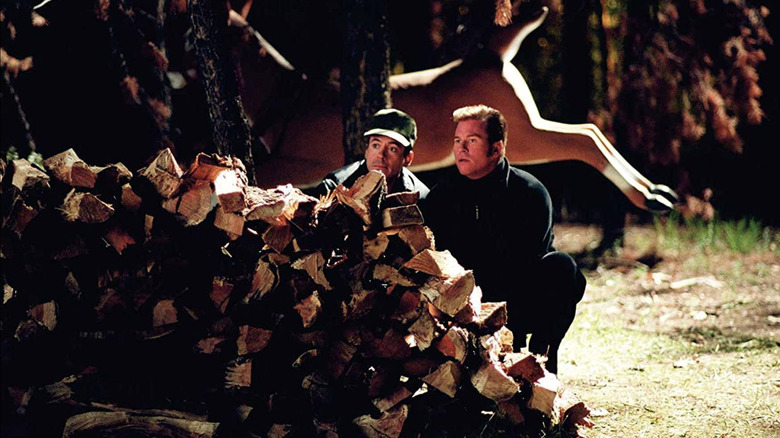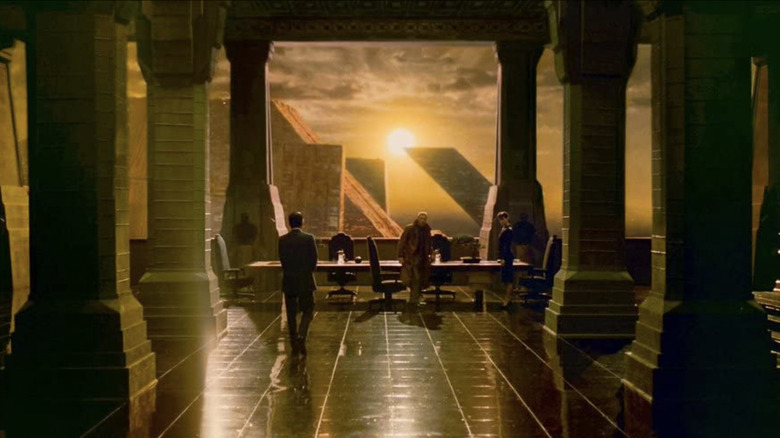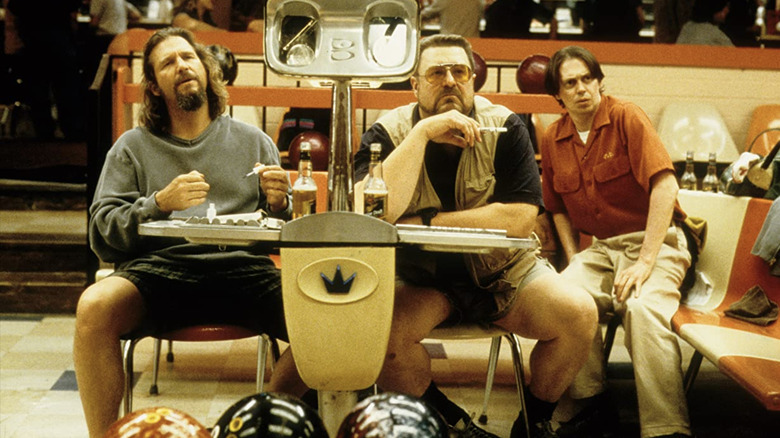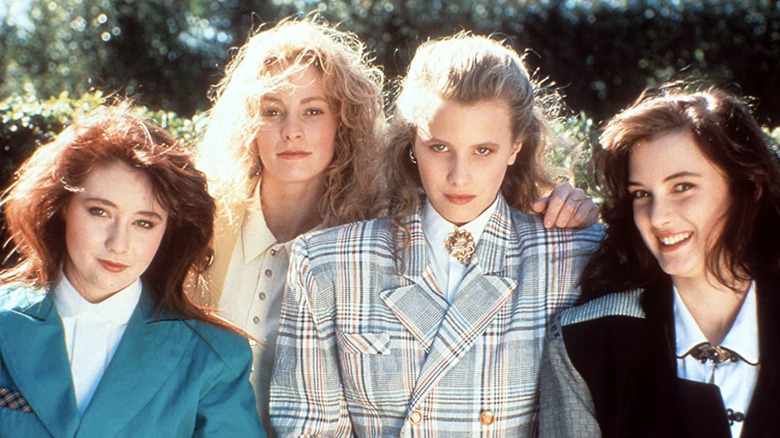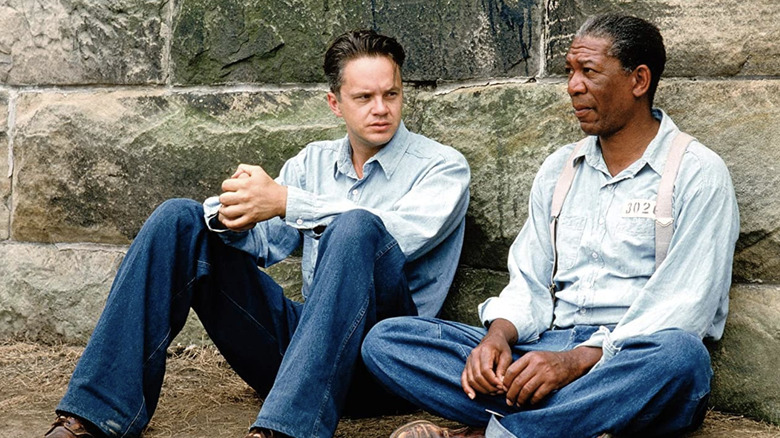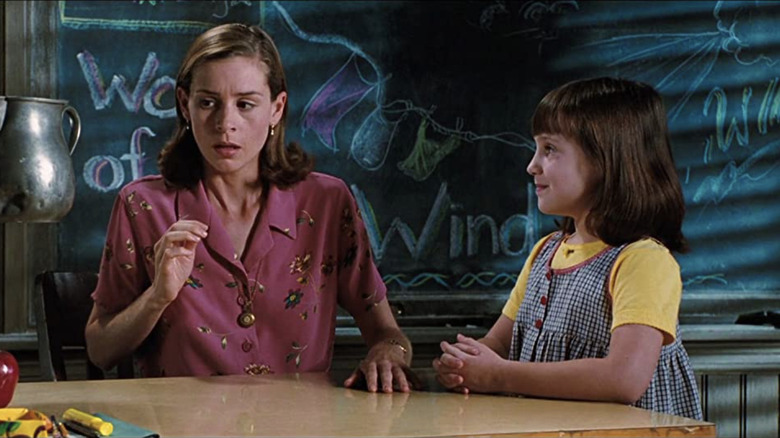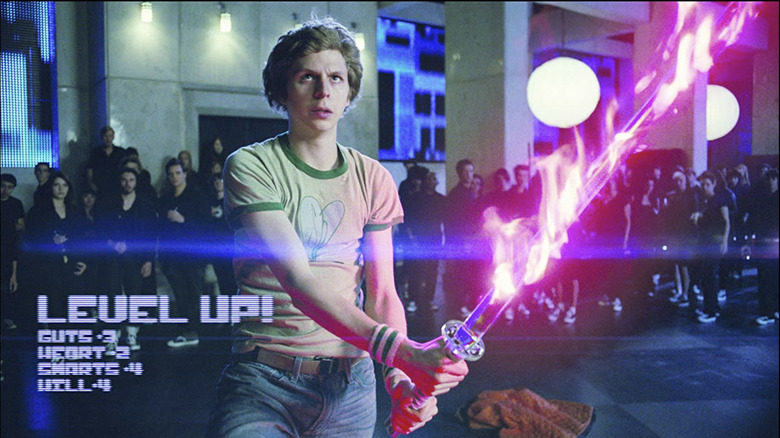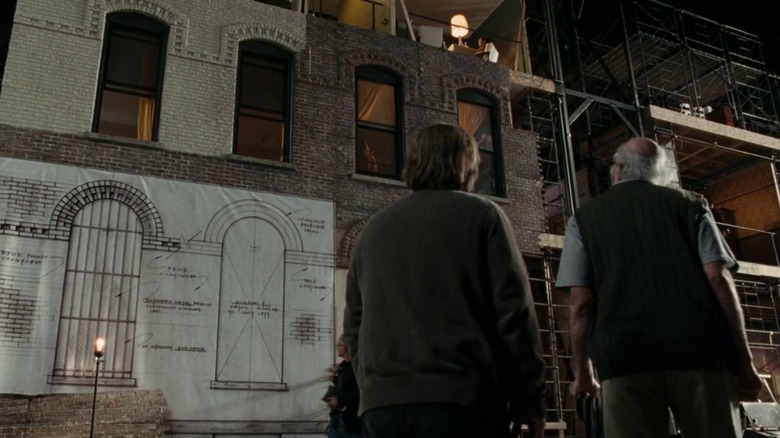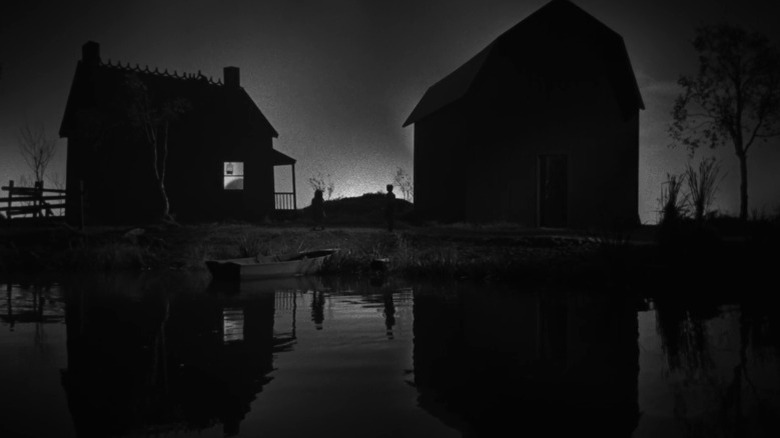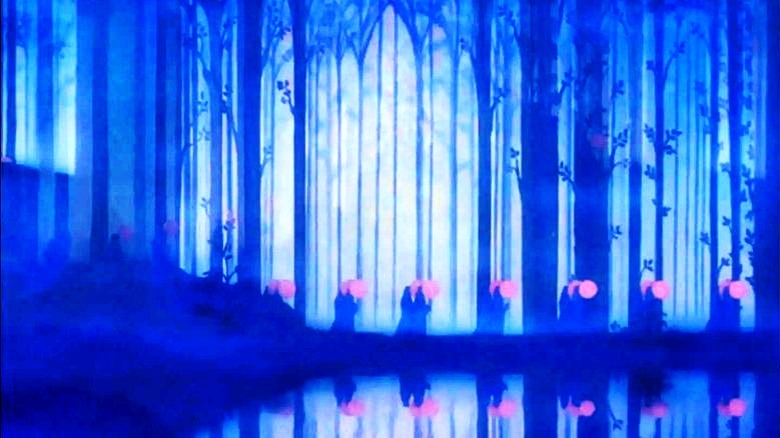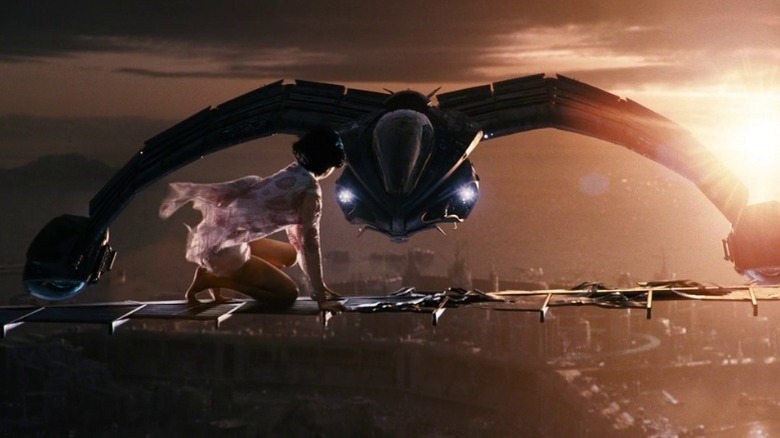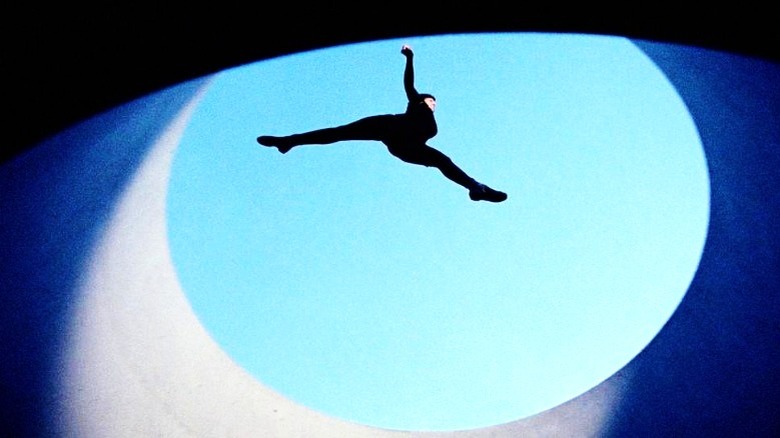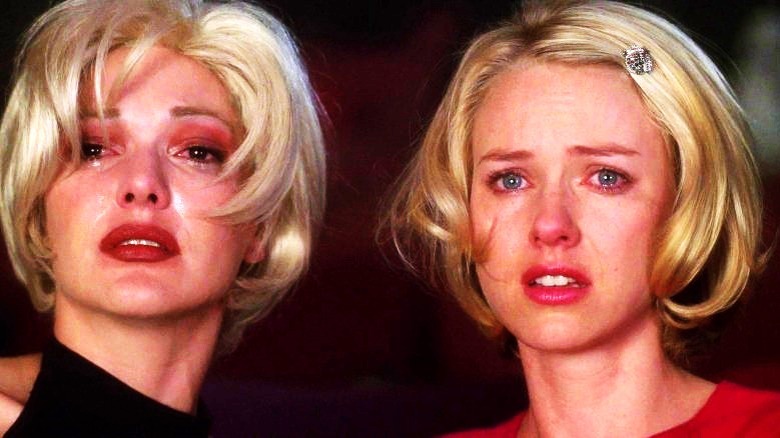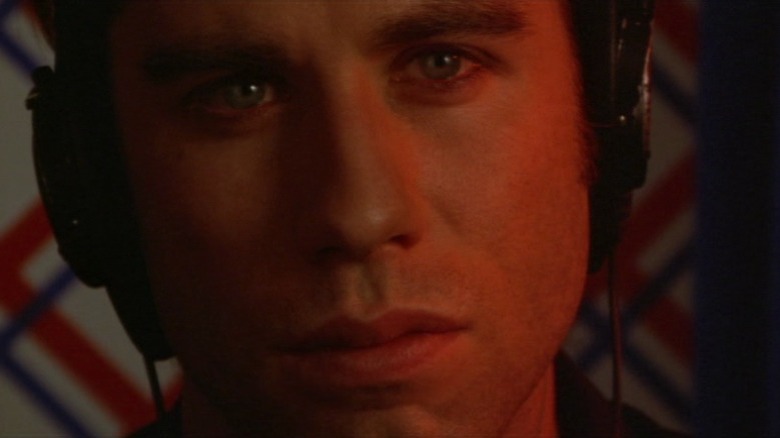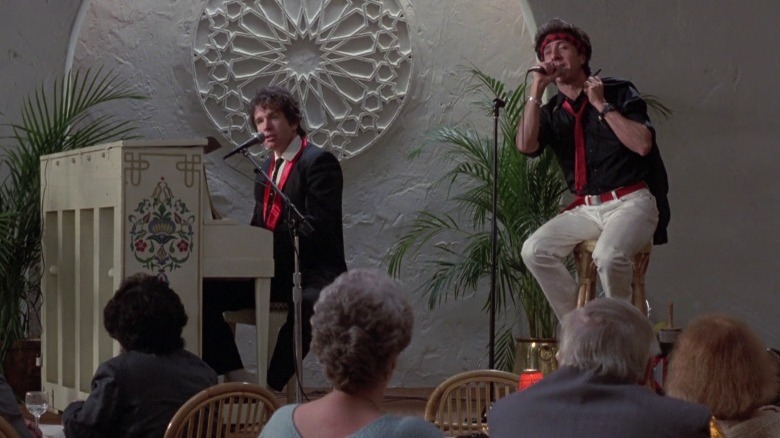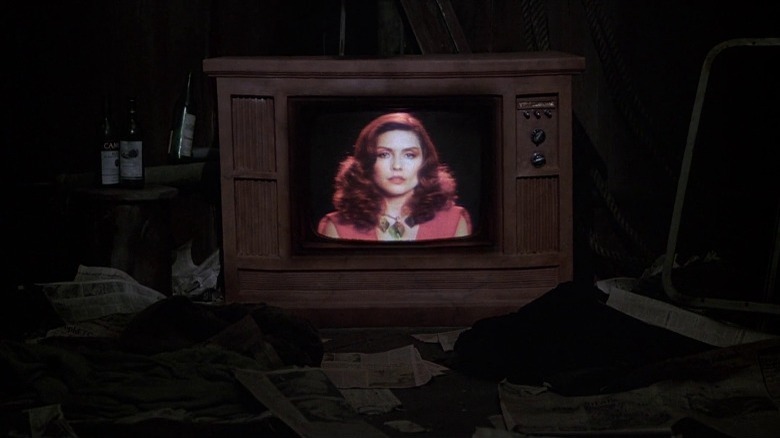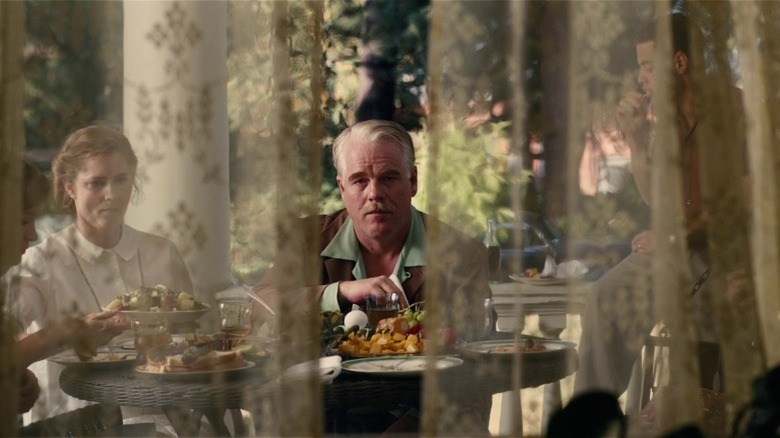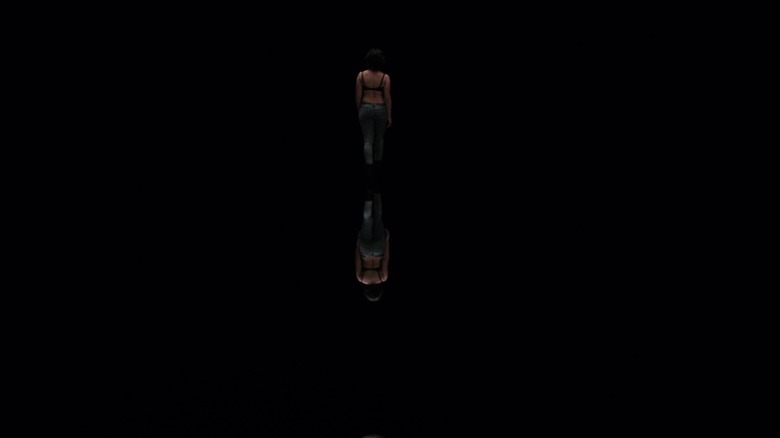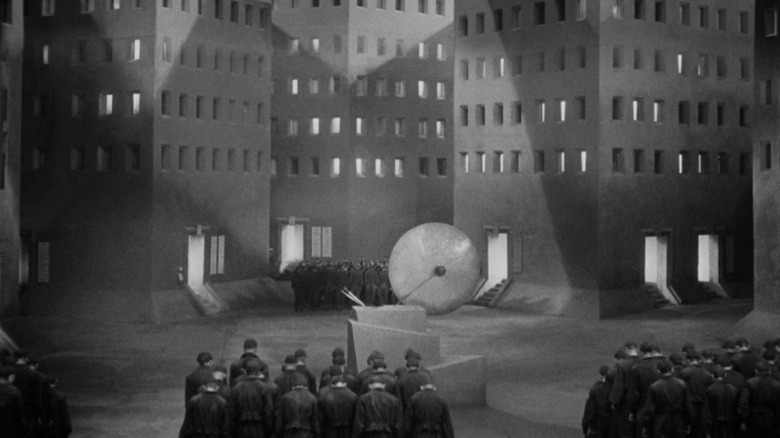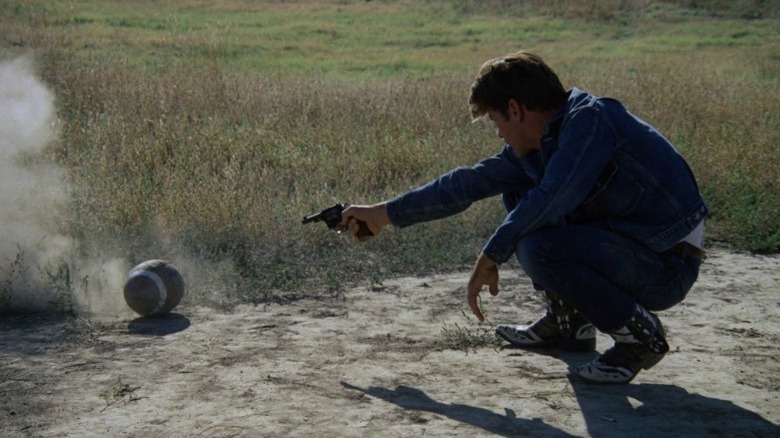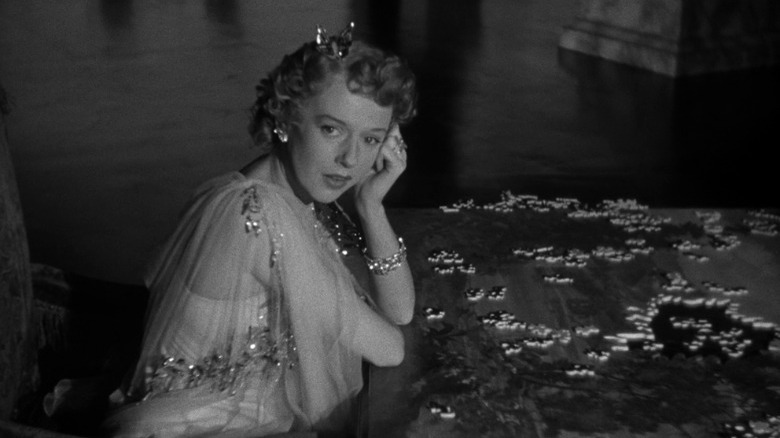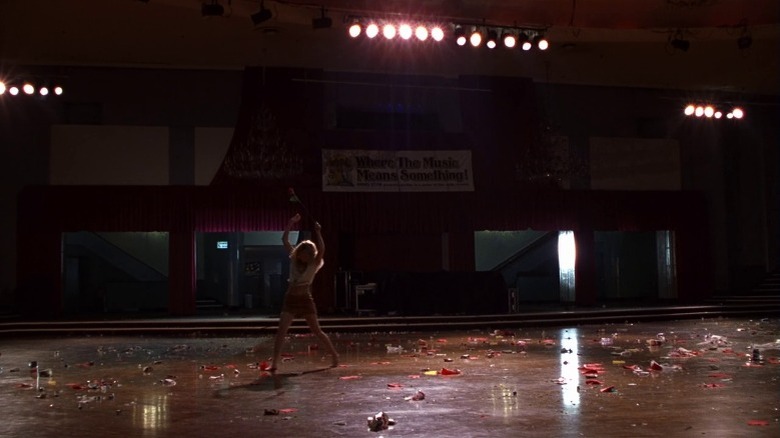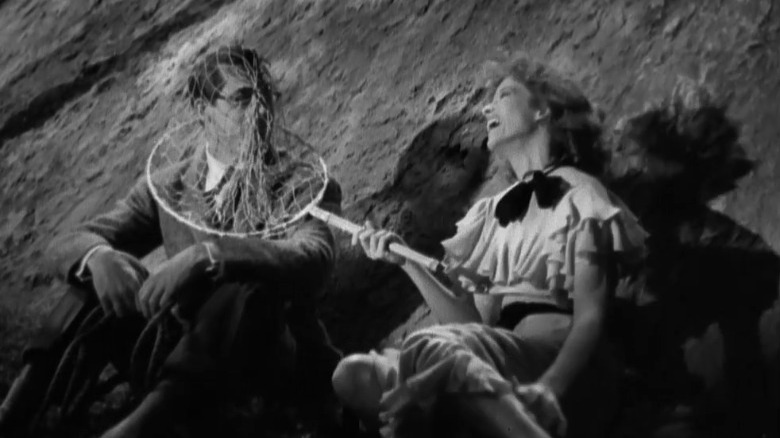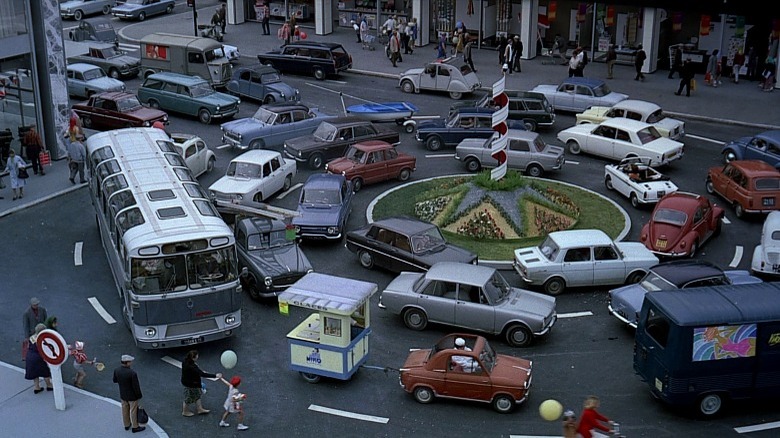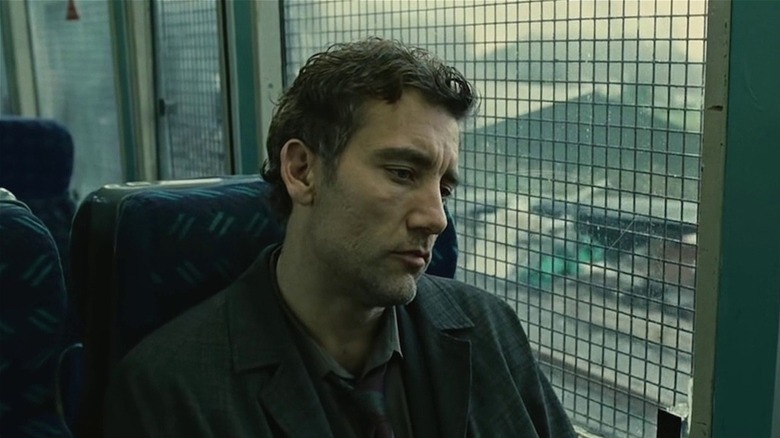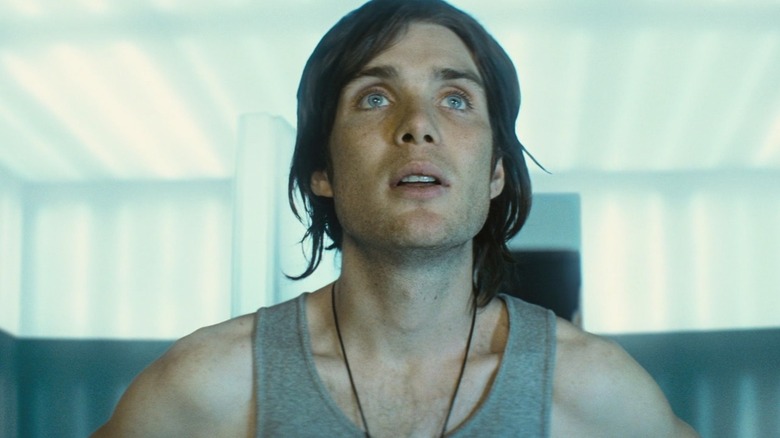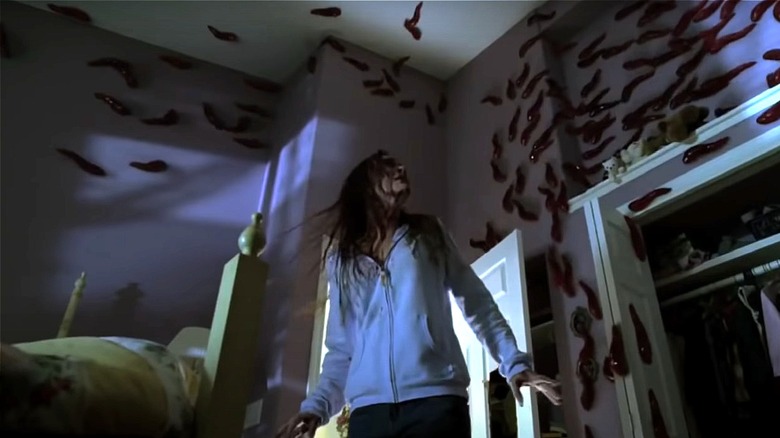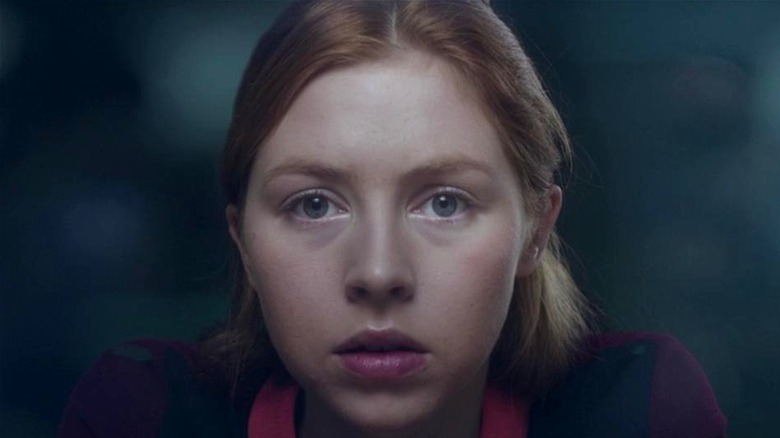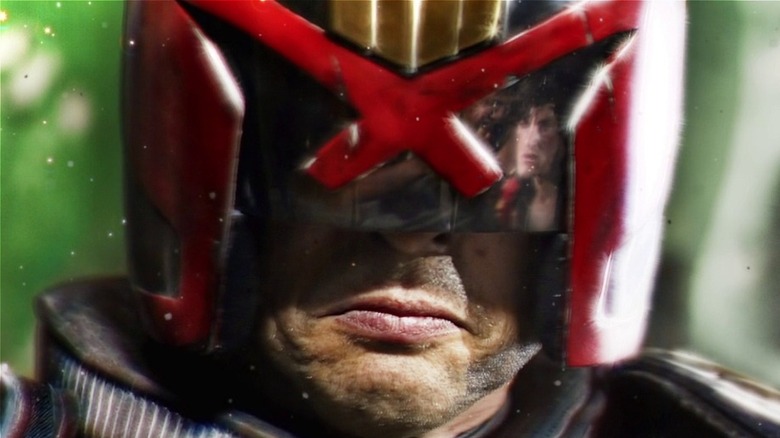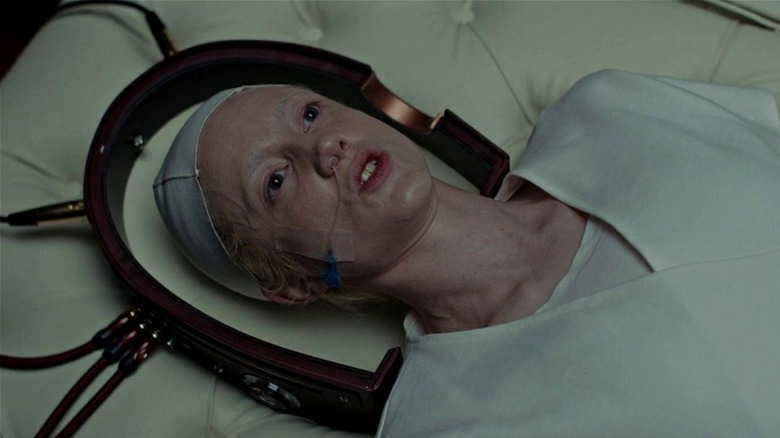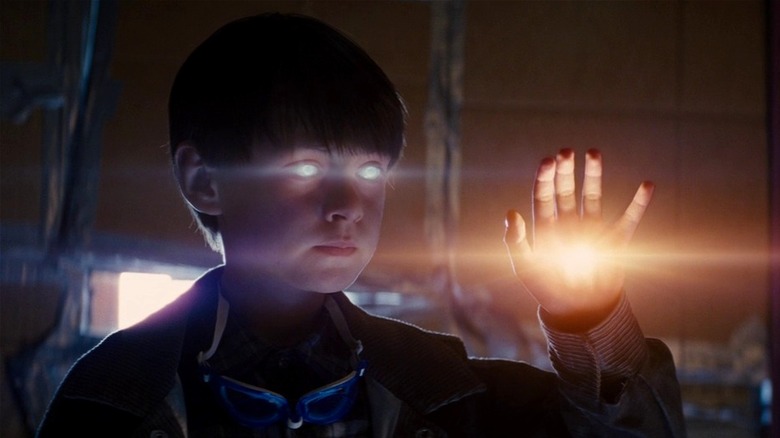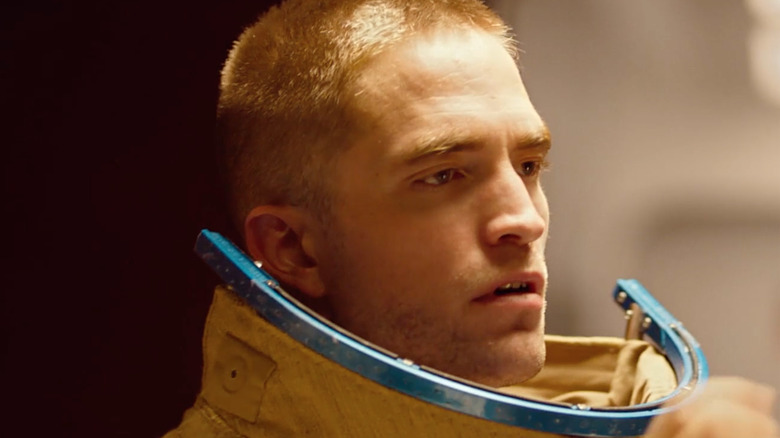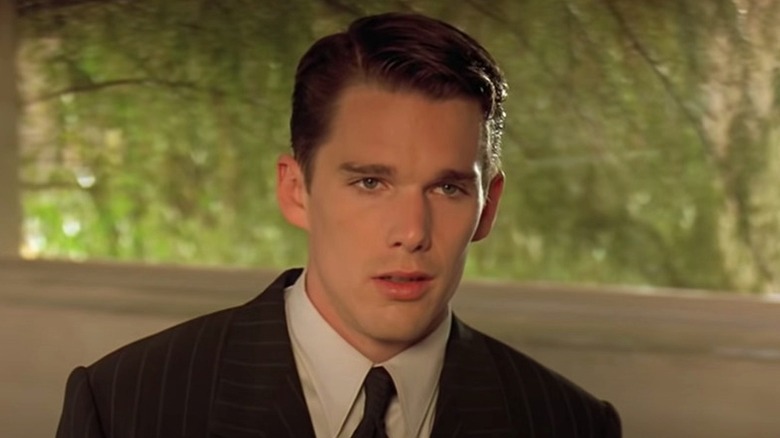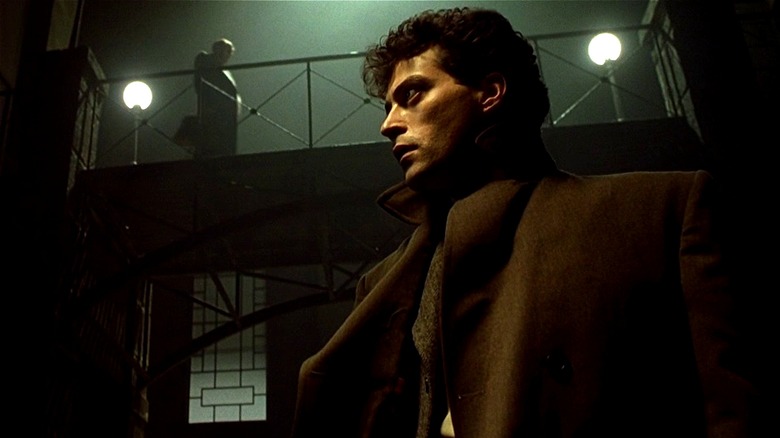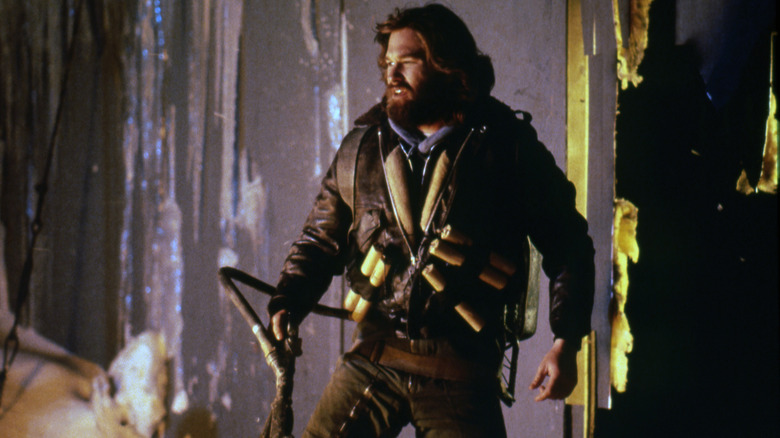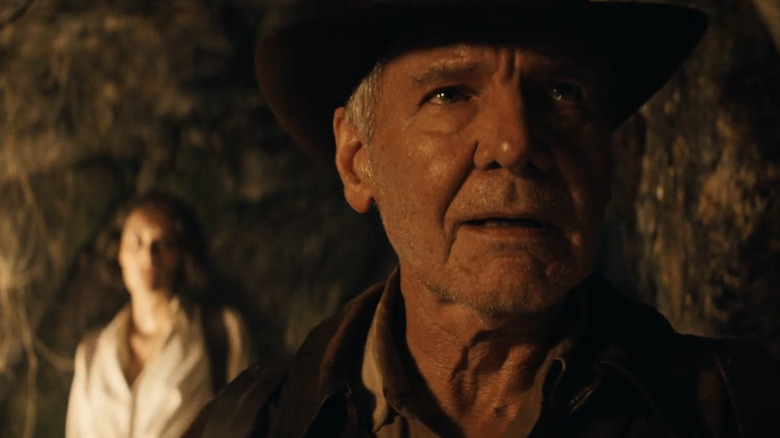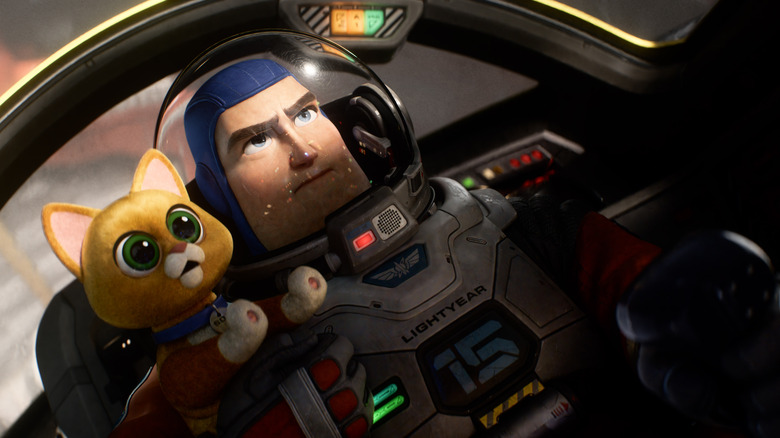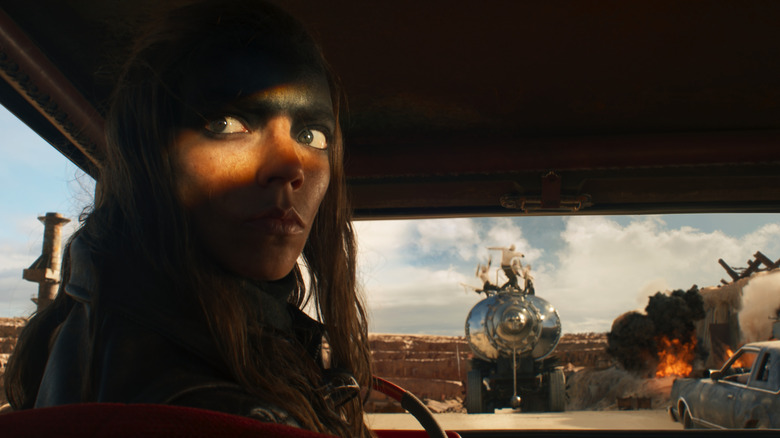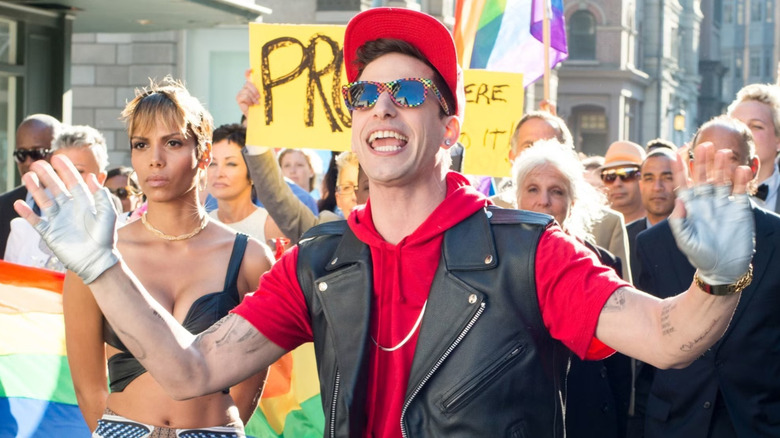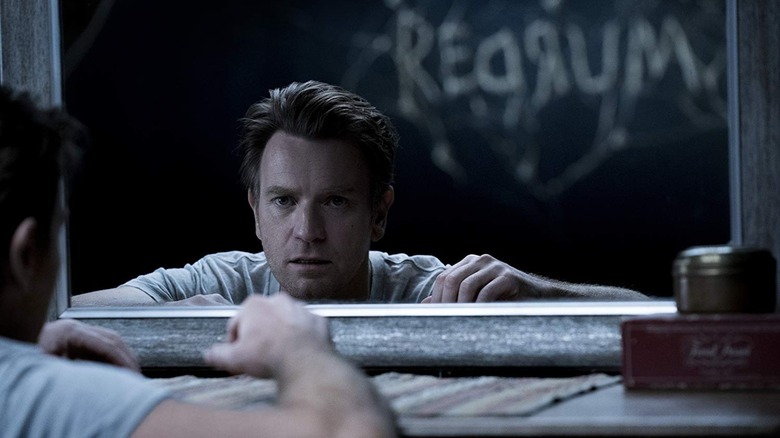46 Box Office Bombs That Are Truly Worth A Watch
Good movies aren't all created equal. While some benefit from great trailers and well-crafted marketing campaigns, other films suffer from a lack of promotion. Sometimes, a good movie is released at the same time as bigger, much-awaited production that overshadows everything else in theaters; it's never a good idea to schedule a movie's opening against the latest entry in a hot franchise or the biggest stars' latest blockbusters.
Whatever the reason, many truly great movies bomb at the box office, even if they garner positive reviews and become critical successes. Those movies often end up being re-discovered after arriving on home video or streaming platforms, and go on to become very popular with the very same audiences that snubbed them the first time around. These are some of the biggest box-office bombs of the last few decades — if you haven't seen them, they're all absolutely worth watching.
The BFG
You'd think a Steven Spielberg movie could never bomb at the box office, yet here we are. Spielberg's 2016 children's movie "The BFG," based on Roald Dahl's classic novel of the same name, was meant to be a summer blockbuster, but failed to bring audiences into the theater, where it was overshadowed by Pixar's "Finding Dory."
While it's certainly not Spielberg's best movie, "The BFG" is still a charming, whimsical film that's sure to entertain families on movie night. With the help of motion capture, Mark Rylance plays the Big Friendly Giant, who kidnaps 10-year-old Sophie (Ruby Barnhill) from the London orphanage where she lives after she spots him on his nightly stroll around the city. See, the BFG can't allow the girl to reveal the existence of giants to the rest of the world, so she has to come with him to Giant Country.
The BFG's job is to spread good dreams to children, and Sophie starts helping him. Other giants, meanwhile, go out and eat children during the night. When they find out about Sophie's existence, she's in big trouble. The movie features some amazing animation and a stunning performance from newcomer Ruby Barnhill, which is unsurprising given Spielberg's talent for casting and directing children.
The Iron Giant
Another tale about a friendly giant makes it on this list. "The Iron Giant," directed by Brad Bird in 1999, had a very disappointing performance at the box office, despite being a critical success. Brad Bird went on to direct classic children's movies such as "The Incredibles" and "Ratatouille," and "The Iron Giant" has all the charm and power you'd expect from a director like that. Thankfully, the movie went on to gather a cult following and made quite an impression in pop culture, with its titular character appearing in recent movies such as "Ready Player One" and "Space Jam: A New Legacy."
The story of "The Iron Giant" is set in 1957 and follows Hogarth (Eli Marienthal), a nine-year-old kid living with his single mother Annie (Jennifer Anniston) in Maine. After an unidentified object crashes in the forest near his home, Hogarth investigates and stumbles onto a 50-foot-tall robot who seems to be made by aliens. The Giant (voiced by Vin Diesel, years before he melted everyone's hearts as Groot) is well-behaved and peaceful, and a quick friendship blossoms. However, a xenophobic government agent named Kent Mansley (Christopher McDonald) is also on the case, and devotes himself to destroying the Giant.
Like all great children's movies, "The Iron Giant" is a parable with a memorable lesson about acceptance. Hogarth defends the Giant, telling his metal friend he can be whatever he chooses to be, even if others are convinced that he is nothing but a weapon.
Treasure Planet
"Treasure Planet," which was directed by Ron Clements and John Musker, came on the heels of Disney renaissance hits like "Beauty and the Beast," "Tarzan," and "Lilo & Stitch." For Clements and Musker, who helmed "The Little Mermaid," "Aladdin," and "Hercules," the idea for "Treasure Planet" had been percolating for a long time. It was a risky, out-of-the-box idea, and even though it was nominated for an Oscar, it was a flop at the box office.
"Treasure Planet," based on the classic novel "Treasure Island" by Robert Louis Stevenson, is essentially a remake of Disney's 1950 adaptation of the book. It follows the adventures of teenager Jim Hawkings (Joseph Gordon-Levitt), who dreamt of space pirates when he was a kid. Jim gets a mysterious orb after a pirate crash lands near his family's inn, which turns out to house a map to the fabled Treasure Planet, where a famous space pirate has been hiding his loot. Jim and his friend Dr. Delbert Doppler (David Hyde Pierce) commission a ship to go and get the treasure, befriending a shifty cyborg cook called John Silver (Brian Murray) along the way.
"Treasure Planet" uses a mix of hand-drawn animation and CGI, and the result is stunning, full of bold steampunk aesthetics and characters like swashbuckling aliens and robots that sail on 18th-century-style ships that shoot laser beams. It's a feast for the eyes, with lots of humor and charm.
Hocus Pocus
Directed by Kenny Ortega in 1993, "Hocus Pocus" didn't really make any waves when it was released. It was a flop at the box office, and critics panned it. It didn't help that it was competing against the likes of "Jurassic Park" and "Free Willy," and that it was released in the summer rather than the fall. However, through multiple showings on TV during the autumn season as well as numerous home video releases, "Hocus Pocus" has became a Halloween classic and a fan-favorite, spawning endless memes and themed parties.
"Hocus Pocus" tells the story of the three Sanderson sisters — Winifred (Bette Midler), Mary (Kathy Najimy) and Sarah (Sarah Jessica Parker) — who were executed in Salem for being witches in 1683. That wasn't the end, though. The sisters vowed to come back to haunt the village once more; they just needed a virgin to light the black flame candle at their cottage. In 1993, the Sandersons make good on their promise, showing up in a very different Salem on Halloween night.
Max Dennison (Omri Katz) is the one responsible for their return. Newly resettled from California, Max is skeptical about the Sanderson sisters' story and convinces his crush Allison (Vinessa Shaw) to bring him to their cottage. Max, his little sister Dani (Thora Birch), and Allison spend the rest of Halloween night trying to stop the evil sisters. "Hocus Pocus" is a fantasy coming-of-age adventure that's still a highly entertaining, family-friendly movie.
Hugo
"Hugo" was director Martin Scorsese's first attempt at making a children's movie, as well as his first time playing around with 3D. Unfortunately, leaving behind the mean streets for a whimsical tale didn't work too well for the famous director. Released in 2011, "Hugo" went up against the Twilight Saga's penultimate film as well as "The Muppets." Critics were impressed with Scorsese's foray into family-friendly territory, but "Hugo" was considered a major flop.
Based on the 2007 novel "The Invention of Hugo Cabret" by Brian Selznick, "Hugo" follows its titular character, a young boy (played by Asa Butterfield, in a great performance) living in a train station in Paris. After Hugo's dad (Jude Law) passes away, Hugo lives with his uncle, who's in charge of maintaining the clocks around the station. When his uncle disappears, Hugo carries on his job in secret. He also keeps an old, broken automaton that his dad used to have; Hugo attempts to fix it, stealing parts from a toy store inside the station.
The toy store is owned by George Méliès (Ben Kingsley), the real-life French filmmaker who is considered by many to be the father of special effects. The film also stars Chloë Grace-Moretz, Helen McCrory, and Sacha Baron Cohen, and is a love-letter to cinema and its beginnings, with much of the second act centered around Méliès' legacy. Scorsese's use of 3D is restrained and clever, and he has a lot of fun with the technology, making for as beautiful a film as you'd expect from such a talented, prolific director.
Peter Pan
Directed by P.J. Hogan in 2003, this adaptation of J.M. Barrie's classic novel "Peter Pan" was somewhat of an oddity on Hogan's resume; he had previously directed the comedies "Muriel's Wedding" and "My Best Friend's Wedding." Its critical response was positive, with many critics noting how faithful it was to its original book, but it couldn't make a place for itself in that holiday season's crop of films, which included "The Lord of the Rings: The Return of the King" and "Cheaper by the Dozen."
This version of "Peter Pan" doesn't shy away from the complicated feelings that come with getting older, which is maybe why it made fans of the novel so happy — like Captain Hook says, growing up is a nasty business. Australian Jeremy Sumpter takes on the titular role, while newcomer Rachel Hurd-Wood turns in a stunning performance as Wendy. The sexual tension between the two is sweet and natural, even if it's masked by their roles as the Lost Boys' surrogate mother and father. Scenes in which they recreate the fairies' dancing, or share their first kiss, are full of melancholy and wonder.
Jason Isaacs plays the dual role of Mr. Darling and Captain Hook, and French actress Ludivine Sagnier takes on the part of the cute but annoying fairy Tinkerbell. The movie is not all sensuality and sentimentality, either; it also features great sword fights and dramatic cinematography by Donald M. McAlpine, who shot "Moulin Rouge" for Baz Luhrmann.
Kiss Kiss Bang Bang
If "Die Hard" is a Christmas movie, then crime comedy "Kiss Kiss Bang Bang" should be one, too. The directorial debut of screenwriter Shane Black, the film stars Robert Downey Jr. as Harry Lockhart, a New York City burglar who stumbles into an audition as he flees the scene of a failed heist. His remorse is mistaken for method acting by the casting director, and he's sent to Los Angeles to be tutored by a real-life detective, Gay Perry (Val Kilmer). There, Harry runs into his childhood crush Harmony (Michelle Monaghan) at a party, and lies to her about being a private detective. A series of unfortunate, and sometimes wacky, events unfold from there.
Shane Black is known for writing funny, snarky films like "Lethal Weapon" and "The Long Kiss Goodnight," and "Kiss Kiss Bang Bang" is no exception. It didn't perform well in theaters, barely managing to make back its budget at the worldwide box office; as a domestic release, it was a major flop. In any case, the film marked Downey Jr.'s return to Hollywood (and led to his casting in his most well-known role, Iron Man), and features great performances by both him and Kilmer.
Blade Runner
Directed by Ridley Scott in 1982, "Blade Runner" is a neo-noir cyberpunk movie that, much like Scott's "Alien," redefined the sci-fi genre. "Blade Runner" is based on the 1968 novel "Do Androids Dream of Electric Sheep?" and is set in Los Angeles, where a corporation called Tyrell is making bio-engineered robots called replicants to work as slave labor. Cops known as Blade Runners hunt down and "retire" (a nicer word for killing) runaway replicants; one such cop is Rick Deckard (Harrison Ford), who is looking for a group of replicants led by Roy Batty (Rutger Hauer). "Blade Runner" also stars Sean Young as a beautiful replicant named Rachael, who's Deckard's love interest.
The film's box office performance was affected by other major fantasy and science-fiction movies coming out around the same time — competing titles included "Star Trek II: The Wrath of Khan," "Conan the Barbarian," and "E.T. the Extra-Terrestrial." It also happened to be a polarizing movie for critics. While some loved it, others were very critical. Nevertheless, "Blade Runner" gathered an impressive cult following and is now considered a masterpiece of science fiction. Its moody atmosphere and urban, neon-light jungle set the standard for what cyberpunk films would look like going forward.
The Big Lebowski
While it wasn't a total flop, "The Big Lebowski" was certainly a commercial disappointment, and wasn't well-liked by critics. Directed by Joel and Ethan Coen, who had just won an Oscar for writing "Fargo," "The Big Lebowski" was released to great hype. It didn't get any award nominations, but it remains one of the Coen brothers' most quotable movies.
In a classic plot of mistaken identity, Jeffrey "The Dude" Lebowski (Jeff Bridges) is attacked by debt collectors who are looking for millionaire Jeffrey "The Big" Lebowski's wife. When the Dude refuses to cooperate, the thugs pee on his favorite rug. The Dude is a deadbeat — unemployed, his days consist of sipping White Russians and bowling with his pals Walter Sobchak (John Goodman) and Donny Kerabatsos (Steve Buscemi). When he confronts the Big Lebowski (David Heddleston), the Dude ends up hired to search for Bunny (Tara Reid), Lebowski's kidnapped wife. The film also stars actors like Julianne Moore and Philip Seymour Hoffman, and features all of the Coen brothers' signatures: witty dialogue, ridiculous plot devices, and great political and social commentary.
Heathers
"Heathers" was intended to be as a high-school comedy, and while it's very funny, it's probably better described as a cynical, B-level horror film. Directed by Michael Lehmann in 1988, the film did not please everyone, and critics were quick to put it down as cruel, nasty, and morbid. To say it flopped at the box office would be an understatement. Nevertheless, "Heathers" went on to make a name for itself on video, and has a lasting legacy thanks to its subversive, satirical premise.
"Heathers" follows the story of Veronica (Winona Ryder), whose popular clique consists of three other girls, all named Heather: Heather Chandler (Kim Walker), Heather Duke (Shannen Doherty), and Heather McNamara (Lisanne Falke). Growing tired of them and their bullying, Veronica gravitates towards the rebellious new kid, Jason "J.D." Deam (Christian Slater). They fall in love and discover their shared hatred of the Heathers, and eventually J.D. recruits Veronica for his a plan to murder the bullies and make it seem like they had taken their own lives. What ensues is as gory, shocking, and ridiculous as you'd expect. That's why it works: as Veronica herself says, "Teen angst has a body count."
The Shawshank Redemption
Competing against big titles such as "Pulp Fiction" and "Forrest Gump" didn't do "The Shawshank Redemption" any favors, but its multiple award nominations helped make it a big home video success; "The Shawshank Redemption" is now frequently considered one of the greatest movies ever made. Directed by Frank Darabont, "The Shawshank Redemption" is a prison drama adapted from Stephen King's 1982 novella, "Rita Hayworth and Shawshank Redemption."
Set in 1947 at Maine's Shawshank State Prison, the film follows banker Andy Dufresne (Tim Robbins), who's wrongfully imprisoned for the murder of his wife and her lover. He befriends fellow lifer Ellis "Red" Redding (Morgan Freeman), who is the prison's fixer and smuggler, and makes a name for himself by helping the guards with their taxes and other financial matters. Both Robbins and Freeman deliver strong performances — the film is less about prison and its hardships than it is about friendships, humanity, and hope.
Matilda
Another Roald Dahl adaptation, "Matilda" had a rough time at the box office — that may be because it came out just after "Independence Day." Directed by Danny DeVito and released in 1996, "Matilda" is a delightful movie that can be a bit too dark for young viewers, but it's perfect for older kids and their parents. "Matilda" doesn't take itself too seriously, and goes to great lengths to feature ridiculous villains, slapstick-adjacent action, and moral lessons that never feel too sentimental.
"Matilda" follows its titular hero, a smart six-year-old girl played by the brilliant Mara Wilson, who is badly neglected by her capitalist family. Her dad, Harry Wormwood (Danny DeVito), is a crooked car salesman. Her mom, Zinnia (Rhea Perlman), is a narcissistic bingo addict. Her older brother, Michael (Brian Levinson), is a bully. Things change when Matilda discovers that she has telekinetic powers that match her frustration, as well as when she heads to school at Crunchem Hall, which is run by tyrannical Agatha Trunchbull (Pam Ferris). "Matilda" is a wonderfully funny yet macabre movie that honors its source material — this really does feel like Dahl's work brought to life.
Scott Pilgrim vs. the World
It's hard to imagine that cult movie "Scott Pilgrim vs. the World" was a commercial failure, especially since comic book movies are all the rage right now. Based on Bryan Lee O'Malley's series of graphic novels and directed by Edgar Wright, "Scott Pilgrim vs. the World" came out in 2010 and failed to generate enough enthusiasm to make it a hit. Nevertheless, it was a critical success, gathering numerous award nominations and becoming what is now considered a classic movie with a cult following.
Michael Cera stars as the eponymous Scott Pilgrim, an awkward young man who falls for manic-pixie dream girl Ramona Flowers (Mary Elizabeth Winstead). There's a twist, though: If Scott wants to date the girl of his dreams, he has to defeat all seven of her evil exes first. "Scott Pilgrim vs. the World" has a star-studded cast that includes Chris Evans, Jason Schwartzman, Anna Kendrick, Brie Larson, Aubrey Plaza, and more. The movie is visually breathtaking, borrowing many elements from its source material, making it a unique, genre-bending film.
Synecdoche, New York
"Synecdoche, New York" is about what one might expect from the directorial debut of a mind as expansive and irascible as Charlie Kaufman's. Throughout its runtime, Kaufman's film defies expectations. What's even more fascinating is that Kaufman scraped together a budget of $20 million — a blockbuster-level amount of dough for an independent film, especially in 2008. Kaufman made something guaranteed to repel audiences: The film's ultimate intake of $4.6 million was, in all honesty, about as much as it could have hoped to make. But thank the movie heavens Sidney Kimmel Entertainment cut Kaufman that check because it allowed him to realize one of the most unique and far-reaching visions in American cinema.
The film follows a chronically unhappy theater director, Caden Cotard (Philip Seymour Hoffman), as he makes use of a MacArthur Genius Grant to put on what could be described as the most ambitious theater production of all time — a recreation of his neighborhood of Schenectady, New York, inside of a gigantic warehouse with actors playing the people in his life. In classic Kaufman fashion, the production spirals out of control for years and begins to house plays within plays within plays. This epic feat of metafictional storytelling is rendered in a gargantuan scale by the budget. But it's the aching, universal emotions and existential woes at the heart of the story that make the film a masterpiece.
The Night of the Hunter
"The Night of the Hunter" is a consolidated American classic nowadays, so it's easy to take its cultural ubiquity for granted. It's a timeless film that feels like an essential part of the film world's DNA. But it took some time for the Charles Laughton film to gain the reputation it now has. Upon its original release in 1955, not only was "The Night of the Hunter" critically reviled, but it was a massive audience flop — prompting a distraught Laughton to stop directing altogether.
For cinema history, it's a shame. "The Night of the Hunter" offers evidence that Laughton would have been on track to become one of the Olympic titans of cinema if he'd kept directing. (Heck, this film is more than enough to put him up there with the greats: That's how much of a leap forward it represented for cinema — aesthetically and narratively.) With its fable-like story of two kids (Billy Chapin and Sally Jane Bruce) on the run from a serial killing preacher (Robert Mitchum) who may well be the single purest screen embodiment of evil, "The Night of the Hunter" invented the modern arthouse thriller. Movies flop for several reasons, but in this case, it's safe to say that audiences were not ready yet for its style or substance.
Fantasia
"Fantasia" flopped? Yes, "Fantasia" flopped. There's a reason why Disney never followed through on its plan to keep "Fantasia" in theaters for years on end as a seasonal multimedia entertainment experience, with new segments rotating in and out of the program: At the time, the whole undertaking single-handedly drove the studio to near-bankruptcy.
When you think about it, it's no surprise. Walt Disney had, by that point, spent more than a decade building his studio's rep as a purveyor of safe, comforting, emotionally digestible family entertainment. Neither critics nor audiences expected the Mouse to go avant-garde on them. Walt regretted making "Fantasia" — an overly ambitious enterprise that promised to revolutionize animation, concerts, and film.
Nevertheless, as the years passed, "Fantasia" became a universally recognizable point of reference for experimentation and extravagance within the bounds of cinema and a source of inspiration for countless artists and psychedelia enthusiasts. The film's synchronization of classical music masterworks to unbound, mellifluous, intuitively fitting animation packs a wallop. Whether one prefers the abstract light show visualizing Bach's "Toccata and Fugue in D Minor" or the cute animals bopping to Ponchielli's "Dance of the Hours," this film is unlike any other — and an experience everybody owes to themselves to have at least once.
Cloud Atlas
The Wachowski Sisters are the reigning masters of uncompromising, financially inoperable, inevitably underperforming blockbusters that are unparalleled masterpieces. Each of their projects as directors since "The Matrix" trilogy has had a scale of production far outweighing its economic viability. And the result each time has been the same: A film (or TV series) so out-there, so exuberant in its visual and conceptual imagination, so unbound in its employment of resources that you can't believe someone got away with making it.
This list could include the ahead-of-its-time caffeinated neon rush of "Speed Racer." Or the misunderstood forward-thinking mythology of "Jupiter Ascending." Or the poetry and romanticism of Lana's "The Matrix Resurrections." But if we must pick one Wachowski big-budget flop to showcase their Hollywood-subverting genius, it's "Cloud Atlas." Directed by them alongside Tom Tykwer, the film adapts David Mitchell's novel, "Cloud Atlas." The film tells six stories of courage and revolution scattered across human history — from the Chatham Islands in 1849 to post-apocalyptic Hawaii in 2321. Each segment features the same actors in different roles and intercut with relentless, mind-blowing Kuleshovian precision — in service of a grand tapestry with myriad meanings and emotional rewards. If there was a movie that made you feel every cent of its budget, this is it. When the Wachowskis put on a spectacle, they go-for-broke!
Æon Flux
Speaking of directors whose box office woes have plagued their careers, it's time the film industry does right by Karyn Kusama. Despite being one of the best directorial talents of her generation, Kusama has only been able to put out five feature films in the 22 years since she broke through with "Girlfight." Several productions became marred by studio meddling, senseless marketing, and misguided critical assessments. None got a worse shake than "Æon Flux."
Since its 2005 premiere, this Charlize Theron-starring action film has become synonymous with a catastrophic blockbuster production. Paramount ultimately found Kusama to have made a "$50 million art movie" and took the film away from her for heavy re-editing. That didn't save the day: "Æon Flux" flopped hard, and the director eventually disowned it. You can feel the studio meddling in the version of "Æon Flux" we ultimately got. The film, which tells the story of a skilled assassin embroiled in the political turmoil of a post-apocalyptic world, is incoherent and jumps from shot to shot with clunking awkwardness. But what's in the frames is never less than astonishing. With dense world-building, unique neo-brutalist imagery, and imaginative setpieces, Kusama fashions the kind of uber-cool futuristic world you want to lose yourself in throughout its runtime. Even if we never get to see the totality of her vision, what little of it comes through in "Æon Flux" is enough to make it vital sci-fi viewing.
Mulholland Drive
David Lynch movies have never been an easy sell. But when "Mulholland Drive" debuted in 2001, even his fans were impressed by how far the modern master of American surrealism had pushed himself. The film, a feverish Hollywood nightmare that becomes more hectic and mind-boggling as it unfolds, grossed $20.7 million worldwide against a $15 million budget. By industry standards, it's a financial disappointment.
Nowadays, it goes without saying that "Mulholland Drive" is a modern classic: We're talking about a film that got voted by Sight & Sound as one of the 10 greatest films in cinema history, after all. But no descriptions of the immense acclaim and academic importance accrued by "Mulholland Drive" over the years could do justice to the experience of watching it.
"Mulholland Drive" begins with a seemingly simple tale following a wide-eyed newcomer to Tinseltown with dreams of stardom (Naomi Watts), an amnesiac woman with a mysterious past (Laura Harring), and a film director getting pushed around by higher-ups (Justin Theroux). As these their storylines intersect, Lynch methodically breaks down barriers of plot, character, the film medium, and reality itself. Each viewer will have their answers and be rattled by the film's rendition of the festering rot at the heart of Hollywood.
Blow Out
Directed by neo-noir extraordinaire Brian De Palma, "Blow Out" stars John Travolta in arguably the dramatic performance of his career. "Blow Out" is often grouped with two other movies — 1966's "Blow-Up" and 1974's "The Conversation" — in an unofficial trilogy of great modernist films about men seeking murder clues in media. Unlike those financially successful films, "Blow Out" was a massive box office flop, grossing only $13 million against an $18 million budget. However, now audiences recognize its brilliance as much as the Antonioni and Coppola masterpieces.
Whereas "Blow-Up" and "The Conversation" had an implicit political critique, "Blow Out" brings politics to the forefront by spotlighting Jack Terry (Travolta) as a horror movie sound technician who fortuitously records possible evidence of a murder plot involving the Governor of Pennsylvania. Like any De Palma protagonist, Jack feels compelled by voyeuristic curiosity to crawl further into danger. What ensues is one of the most efficiently nerve-racking and engrossing thrillers in De Palma's career. As if the sheer entertainment factor isn't reason enough to watch it, "Blow Out" is also a fascinating meta-cinematic treatise on the nature of movies and our relationship to them — especially apt by the context of then-nascent Reagan's America.
Ishtar
A film's reputation is often much more affected by hype and box office narratives than by its form and content. For years, "Ishtar" routinely made lists of the worst — not the least successful or the least popular or the most financially cumbersome, mind you, but the worst — films of all time. Watch it today, and you might find yourself wondering why. Separate from the context of its troubled production and colossal box office failure in 1987, the film is first and foremost delightful — if slightly messy and unpolished.
Really, what more could one want? The mastery of timing, farcical organization, anarchic mise-en-scène, and understated political satire displayed by Elaine May in all her directorial efforts is on full display in "Ishtar." If anything, the production's atypically large scale and voluminous budget only magnify the filmmaker's gift for laugh-out-loud fun. Dustin Hoffman and Warren Beatty star as ridiculously untalented lounge singers who travel to Marrakesh, Morocco, for a hotel gig. But they end up bumbling their way into the center of a Cold War chess game between royals, CIA agents, and rebels. "Ishtar" exemplifies what big-budget Hollywood studio comedy can offer. Hollywood itself may have spent decades vehemently disagreeing, of course — but that's just part and parcel with its overarching failure to do right by one of the most original and vital auteurs in the past 50 years of American cinema.
Videodrome
Following the overachieving success of 1981's "Scanners," "Videodrome" was the first David Cronenberg film to be backed by a major Hollywood distributor and buoyed by a big budget (by horror standards). But the box office gods are cold and brutal. When it made its way to theaters in February 1983, "Videodrome" became the first proper flop of Cronenberg's career.
As tends to be the case with Cronenberg, it's not hard to understand why audiences recoiled from this festering open wound of a film. But the things that make "Videodrome" so disturbing are, in typical auteurist fashion, also the things that make it a high mark in the genre's history. Few films before or after it have dared to take such an unflinching look at the role sadism and masochism play in cinema's structure. Watching it is like having a mirror held up to yourself and seeing rotting flesh.
Flesh, incidentally, is a vital part of the film. Max Renn (James Woods), the president of a trashy Torontonian TV station, happens upon the mysterious broadcast of "Videodrome," a show depicting gratuitous torture and murder. He decides to air it on his network. As the nature of the "Videodrome" show reveals itself, the film morphs into a singular mélange of conspiracy thriller, urban sci-fi, and Lovecraftian nightmare — while remaining staunchly resistant to easy categorization.
The Master
In the months leading to the release of "The Master," it was hyped as a potentially world-stopping event, not to mention a surefire Academy Award frontrunner. A hot-button period drama about Great Themes, starring Joaquin Phoenix, Phillip Seymour Hoffman, and Amy Adams, and marking the return of Paul Thomas Anderson to the director's chair five years after "There Will Be Blood"? Get out of here! But there was one thing the pundits didn't count on: That the movie would be so strange, maddening, abrasive, and unconventional that it would fail to make back its budget.
The awards run of "The Master" was modest, as box office bombs are wont to be. "The Master" is a clear example of how much industry awards favor success over craft: Still, it has stood the test of time as one of the defining American dramas of the 2010s. This film's power and precision have fueled passionate discussions for over a decade. Anderson's story focuses on a post-WWII religious cult, interweaving it with a character study about a frazzled and directionless veteran (a fearless Phoenix). The movie is an uncompromising masterwork in a directorial career chock-full of them. If not from us, take it from Anderson, who famously considers it his favorite work in his filmography.
Under the Skin
Jonathan Glazer is a sort of Halley's Comet of auteurist filmmaking: Every few years, he gives us a unique cinematic vision, unlike anything we've seen before. He drives audiences mad, and he goes. Glazer's first feature, 2000's "Sexy Beast," was successful enough. But his subsequent films, "Birth" and "Under the Skin," were both exemplary feats of luring viewers in with a beloved superstar actress, then, metaphorically, draining them of life fluid in the dark recesses of an alien contraption.
Like Nicole Kidman in "Birth," Scarlett Johansson gives one of the most astonishing performances of her career in "Under the Skin" — a film that received critical acclaim but failed to recoup its budget. No other movie has ever allowed her to reinvent her physicality and relationship with the camera so thoroughly. Playing an alien who takes the shape of a human woman and wanders about Scotland seducing men into a bizarre parasitic trap, Johansson nails the concept of a non-human being slowly acclimating to humanity — physically and emotionally. The film is the most abstract and image-driven work of Glazer's career so far. With minimum dialogue and virtually non-existent exposition, he dares viewers to understand and feel his disconcerting sci-fi opus for themselves. But Johansson tells a whole story just with her face. See it for Glazer or her, but absolutely see it.
Metropolis
It's no secret to anyone with a passing knowledge of the silent film era that Fritz Lang's "Metropolis" is one of the most ambitious and thrillingly maximalist productions in cinema history — and you don't even have to throw a "for its time" qualifier in there. A daunting visionary from the beginning of his career, Lang made a futuristic sci-fi epic, unlike anything that had graced the silver screen before and succeeded. But so grand was the production scale of "Metropolis" that the movie would need to be a massive hit to begin to turn a profit. To put it mildly, it wasn't — neither in its native Germany nor North America.
Many reasons explain the box office failure of "Metropolis" — from its unfamiliar cinematic lexicon to the clash between its romantic sensibility and the cosmopolitan and politically contentious atmosphere of 1920s Berlin. But the film is a must-watch for any movie lover worth their salt. (We're talking about the movie that invented big-budget sci-fi as we now know it.) It tells a relatively simple story of class, dystopia, love, and revolution — a premise that will now seem inevitably familiar to contemporary viewers watching. But it tells it with such imagination, visual and architectural aplomb, and advanced understanding of the dream-making possibilities of film. You have to see it to believe it.
Badlands
Few figures in American cinema are as shrouded in mystery and myth as Terrence Malick. Even after decades of canonization and hushed reverence, which have made it so that his films' aesthetic and creative marks echo in the work of about a billion different indie filmmakers, there's still no one out there who makes movies quite like he does. But in 1973, Malick was a newcomer making his feature debut. (You can imagine what a splash "Badlands" made at that year's New York Film Festival, where critics bore witness to a Malickian vision for the first time.) "Badlands" also marked the beginning of another Terrence Malick tradition: The audiences' utter rejection of his films.
Although the film was a commercial failure, those with a taste for slow, meditative, off-kilter arthouse movies quickly recognized this was a new voice in cinema. "Badlands" follows an innocent teenage girl (Sissy Spacek) joining up with a troublemaking greaser (Martin Sheen). The pair goes on a killing spree across the American Northwest in the 1950s — a premise that could have become sensationalistic schlock in different hands. But what Malick spins from it is a rare feat of sociocultural reckoning. "Badlands" is a philosophical drama that ventures far into the prairies of midcentury America and searches out a creeping, quietly horrifying sickness at its heart. It's also probably his funniest film — if you can believe it.
Citizen Kane
Every list like this one must reach this point eventually. "Citizen Kane," the long-held consensus critical pick for the best film of all time, was a box office failure when initially released. However, unlike other films on this list, this wasn't a matter of audiences rejecting a bold, confounding new vision: The flop was premeditated — thanks to William Randolph Hearst.
The mighty newspaper tycoon served as a direct inspiration for Charles Foster Kane, the protagonist of the film. Once Hearst heard that a film had been made in his likeness — a film that painted him in a decidedly unflattering light — he mobilized all his power and influence to make sure it would be a failure. Numerous theaters across the country refused to screen the film. For a while, Hearst might have felt victorious in his campaign to keep "Citizen Kane" from being widely seen. Needless to say, things didn't stay that way in the long run!
You've heard it all before: How Orson Welles was a visionary, how "Citizen Kane" represented an astronomical leap forward for films technically and artistically, and how the film's influence looms large over every film made since. But the main thing you should know about "Citizen Kane" as a prospective viewer is what an intensely, relentlessly fun piece of pop drama it is. Forget homework: This is a capital-R Romp.
Almost Famous
For some movies, the status of a flop comes less from how much money it made than how much it didn't. "Almost Famous" is a light-footed comedy-drama road movie with no dazzling VFX or action sequences and features Frances McDormand as its biggest star. Normally, a box office intake of $47 million — enough to place it among the 80 highest-grossing films of 2000, in the same ballpark as hits like "Pitch Black" and "Where the Heart Is" — would be considered an unqualified success. But this breezy road movie cost $60 million to make. In other words, it bombed.
Thankfully, DreamWorks handed over that much money for Cameron Crowe to realize every detail of his epic love letter to the 1970s rock music scene — complete with an enormous music licensing budget to make it more authentic. Crowe based the story of teen music reporter William Miller (Patrick Fugit) on his experiences as a teenage journalist covering tours for Rolling Stone. He made sure every penny went into creating one of the most immersive and satisfying entries in the "music drama" film genre. The film sprawls like a bountiful big-screen adventure. Fugit is our entryway into this world, and Billy Crudup and Kate Hudson (in her breakthrough role) are our luminous field guides. Even that description doesn't begin to cover the raw-nerve humanity that makes "Almost Famous" indelible.
Bringing Up Baby
If one were to take a pick for the single most legendary female star of the Hollywood Golden Age, it would be hard to go with anyone but Katharine Hepburn. An icon on and off-screen, Hepburn brought a level of wit and sophistication to the pre-war studio assembly line that made her internationally revered as the greatest actress of her generation. (The American Film Institute honored her as Hollywood's greatest female screen legend). But there was a period in the late 1930s in which Hepburn suffered through a series of lackluster projects, which soured her relationship with audiences and earned her the feared label of "box office poison." In that period, one masterpiece slipped through the cracks: Howard Hawks' "Bringing Up Baby."
This 1938 film marked Hepburn's grand entrance into the world of screwball comedy. In "Bringing Up Baby," the high-strung paleontologist Dr. David Huxley (Cary Grant) meets the free-spirited heiress Susan Vance (Hepburn) and her pet leopard, Baby. Hepburn, previously known for her seriousness and gravitas, surrendered fully to the insanity of Susan Vance's misadventures. She commits to each pratfall and motormouth verbal standoff with the same verve as her dramatic performances. Although critically acclaimed, the film flopped — due to the public stigma associated with Hepburn. But when mainstream audiences re-discovered it years later, it rightfully became a great classic.
Playtime
Here's another film we should all be glad exists! French filmmaker Jacques Tati was already known as a gifted arranger of slapstick by the late 1950s. He brought his skillset as a mime and dancer into staggeringly elaborate feats of blocking and choreography centered around the lovable Tramp-like character of Monsieur Hulot. But for 1967's "Playtime," Tati decided to switch things up. Instead of merely centering Hulot, he endeavored to place his screen alter ego into an ensemble slapstick epic. Hundreds of performers waltzed about the screen and carried dense setpieces, and mini-stories against a gigantic future-Paris set built just for the movie — all shot in pristine 70mm.
Although Tati's spirit was indefatigable, the ambitious production had a series of catastrophes. The film went drastically over budget and required 365 shooting days, with the director bankrupting himself to complete it. Sadly, French audiences in May '68 were not eager to embrace what many saw as an ultra-expensive vanity project from an old-guard master. Ironically, "Playtime" now stands as a document of the all-questioning, anti-consumerist, anti-system spirit of late-sixties French art. Driven by bafflement at the absurdity of the capitalist world as by its auteur's eagerness to impress and entertain, "Playtime" is a whimsical masterpiece.
Children of Men
"Children of Men" did not lack critical admiration during its release in 2006. The Guardian, for instance, wrote that it had "simply the most extraordinary look of any movie around." This wasn't an understatement — "Children of Men" was and still is an awesome sensory experience. So why did it gross just $70 million against a $76 million budget? Marketing, probably. Well, that was 2006's loss. If you still haven't seen "Children of Men," make an evening of it. Streaming is fine, but if you have access to physical media, do it, because Alfonso Cuarón's direction and Emmanuel Lubezki's cinematography are masterful.
"Children of Men" introduces us to the London of 2027, which has become a grungy police state after an 18 year global fertility crisis. Pollution hangs in the air and armored police patrol the streets, but they do not stop regular terrorist attacks, the latest of which almost catches Theo Faron (Clive Owen) outside a coffee shop on Fleet Street. Dressed in a cool dark ensemble, Faron is a former insurgent turned fatalistic bureaucrat and Owen plays him brilliantly, lending the character an insouciant energy similar to that found in "Croupier," Mike Hodges' evocative London neo-noir.
Faron is no friend of the regime but he's not an earnest revolutionary, either. He has resigned himself to easy work and hard drinking. However, his old comrades want him back, and it hurls Faron into the jaws of his broken society.
Sunshine
"Sunshine" is about the end of life, Earth, and the solar system, but the imagery and score have such a vast, serene effect that a lot of Danny Boyle's film feels like an ASMR video. Inky spectacle chills you as the spaceship Icarus II drifts towards the sun carrying a squad of astronauts led by physicist Robert Capa (Cillian Murphy), who must deliver a stellar bomb into the sun's dying core. This, we're told, should restart the gaseous ball and save the solar system.
The stakes couldn't possibly be higher, but it's all so ludicrous and flatly performed that there is little to invest in. This may explain both the mixed critical response and the trifling box office returns, which covered $26 million of its $60 million budget. Still, there are things to like about "Sunshine," especially when it depicts space's mind-boggling peril. A sequence involving an explosion and harrowingly low temperatures is a particular highlight.
Slither
In 1997, long before he became part of the Marvel machine, director James Gunn worked for that other American media empire — Troma Entertainment. Gunn got his first writing credit on "Tromeo and Juliet," and it was clearly the work of a young man who had grown up on "Night of the Living Dead" and the "Friday the 13th" series.
In 2006, Gunn channeled all of this genre education into "Slither," his directorial debut. The film concerns a meteor-bound parasite that crashes into Wheelsy, South Carolina, and proceeds to infect Grant (Michael Rooker), who morphs into a hideous entity bent on spreading the alien's larvae. What ensues is B-movie literate carnage replete with all manner of gore and grotesquery, yet "Slither" grossed just $12 million against its $15 million budget. That's in the era of "Saw" and "Hostel," which each spawned multi-million dollar franchises. If you want a quick fix of both laughs and nausea, look no further.
Sea Fever
If one had to give an elevator pitch for "Sea Fever," they may be tempted to stick with simply "'The Thing' on a boat." Don't expect torrents of gore, though, because "Sea Fever" is an understated horror piece that favors measured suspense, for better or worse.
Neasa Hardiman's film concerns Siobhan (Hermione Corfield), a PhD student studying with a trawler crew off the Irish coast. Their boat collides with an unidentified mass that stops the vessel in its path and covers part of its hull in a strange slime that, upon investigation, proves to be hazardous. Soon, the crew lose control of the situation and succumb to both the slime's untold danger and the ocean's maddening isolation.
"Sea Fever" was one of few films to somewhat benefit from COVID-19, owing to the timely parallels between the global pandemic and the film's microcosmic equivalent. Still, that didn't help "Sea Fever" at the box office, where it earned just $254,911 during its theatrical run.
Dredd
We should be on the fourth or fifth "Dredd" film by now. We should have a whole "Dredd" universe (because every franchise is a "universe," of course). But we don't. We have to make do with "Dredd" from 2012 and "Judge Dredd" from 1995, if we're really desperate. This is because Pete Travis' film grossed just $41 million on its $45 million budget. "It was a failure in marketing," star Karl Urban told Den of Geek, "not filmmaking."
It's a pity that so few got to see "Dredd" on the big screen, because it's an aggressively visual experience. It imagines Mega-City One, an immense concrete sprawl that covers America's East Coast from Boston to Washington D.C. Judge Dredd (Urban) narrates our introduction to the city's grim skyline, running us through his grim reality as we see an unending line of megablocks rising from a flat, hazy conurbation.
Such a place breeds only bad intentions, and Judge Dredd's patch is full of them. A drug called Slo-Mo is ravaging numerous mega blocks including Peach Trees, which is ruled by Ma-Ma (Lena Headey), a violent and tyrannical drug dealer. When Dredd and his partner Cassandra Anderson (Olivia Thirlby) investigate Peach Trees, Ma-Ma locks the building's mighty exits and wages all out war, initiating what amounts to a science fiction version of "The Raid," the frenetic Indonesian action film released the year prior.
Possessor
"Possessor" made just $911,180 during its theatrical release in the fall of 2020, when COVID lockdowns were continuing to restrict the film industry around the world. It's a pitiful amount for what is one of the darkest science fiction films in recent memory. The titular possessor is Tasya Vos (Andrea Riseborough), an assassin who carries out hits while assuming other people's bodies. She does this with an implant in her host's brain, which she controls with sophisticated VR-like technology administered by Girder (Jennifer Jason Leigh), a former assassin. As Vos imitates and murders, she edges closer to Girder's vision for her — an amoral killing machine.
The film is written and directed by Brandon Cronenberg, and he has clearly taken the baton from his father David, director of classic body horror like "Videodrome" and "The Fly." Like those films, "Possessor" is a story of technology, humanity, and the way they clash with hideously bloody consequences ... and I really mean bloody.
Midnight Special
"Midnight Special" is director Jeff Nichols' third film starring Michael Shannon, the pair having previously collaborated on "Shotgun Stories" and the memorably intense "Take Shelter." After those two, "Midnight Special" should have been a sure thing, but audiences did not turn up, bringing box office returns of just $7.6 million against an $18 million budget.
Perhaps genre confusion had something to do with it, because the film opens like a neo-noir, with Roy (Shannon) and Lucas (Joel Edgerton) on the run with a kidnapped boy named Alton (Jaeden Martell). These men are not monsters but rekindlers, for Roy is Alton's estranged father and he and Lucas have taken the boy from a religious cult seeking to exploit him.
This isn't the usual cultish exploitation, though, because Alton is not an ordinary boy. He possesses great powers that range from perfect imitation to uncontrollable releases of energy, typically from his eyes, which must be guarded with swimming goggles. Together, Roy, Lucas, and Alton's mother Sarah (Kirsten Dunst) must protect him from the cult and the US Government, which sees Alton as a valuable weapon. "Midnight Special" is a science fiction film for those who favor realist aesthetics.
High Life
If you want an art house film in space, then try "High Life." Starring Robert Pattinson, it's a slow burn psychological horror about a gang of death row inmates who are sent to space to extract energy from a black hole. Yes, this is an absurdity, but Claire Denis' film is also quite watchable, even with the deliberate pace and improbable premise.
Pattinson gives a level-headed turn as Monte, a man with routine and resolve despite his death sentence, which he received for murdering his childhood friend. His peers include Boyse (Mia Goth), Tchemy (Andre Benjamin), and Dibs (Juliette Binoche), a doctor who leads the expedition and practices artificial insemination experiments on the crew.
You would expect Dr. Dibs to be a non-criminal with a team of guards, but she is also on death row for killing her family. Why she has been given this responsibility is not clear. Like I said, "High Life" makes as much sense as a PhD in cosmology. Still, it's an artfully staged film that benefits from an aberrant energy that's by turns violent, erotic, and sometimes both.
Gattaca
Eugenics was a fashionable school of thought in certain circles at the turn of the 20th century — in part, that's how the Nazis happened. Fortunately, the idea of changing or "improving" human genetics has fallen out of political favor in the time since, but not in "Gattaca," which imagines a totalitarian world in the near future that categorizes people as "valids" or "invalids."
Vincent Freeman (Ethan Hawke) is an "invalid," and tests say he is doomed to a short life of illness and suffering. But when he meets Jerome (Jude Law), a "valid" former swimmer who was paralyzed in a car accident, Vincent is given an opportunity to become the first class citizen he has always dreamed of. All he has to do is outwit the government's aggressive genetic tyranny.
"Gattaca" is one of the better political science fiction films of the last 30 years, but audiences were unresponsive. By the end of its theatrical run, Andrew Niccol's $36 million film had grossed just $12 million at the U.S. box office.
Dark City
John Murdoch (Rufus Sewell) wakes up in a hotel bathtub with amnesia and a ringing telephone. He answers it and is told men are after him, for he is suspected of murder. This sounds like something out of 1940s noir, especially with a title like "Dark City," but this cult classic from 1998 is just as much science fiction as it is pulp mystery.
Like most examples of the noir genre, Murdoch descends a moral gradient as he reckons with the allegations against him, only this mad ride involves the "Strangers," who look human but are anything but. Roger Ebert recognized the movie's offbeat genre play, describing it as "a great visionary achievement" that was "so original and exciting" that he thought of "Metropolis" and "2001: A Space Odyssey." Alas, director Alex Proyas' creative gamble didn't pay off in theaters, where it just barely made back its $27 million budget.
The Thing
If you asked 100 people to make a list of the greatest horror films ever made, one of the only entries that would probably end up in the top 10 of every single one of those lists is John Carpenter's "The Thing." It is widely regarded as one of the best blends of horror and science fiction in cinema history, right alongside the likes of Ridley Scott's "Alien." Unfortunately, in its day, Carpenter's masterpiece was a full-blown bomb.
"The Thing" not only opened on the very same weekend as "Blade Runner," but both movies were also absolutely buried by Steven Spielberg's "E.T.," which went on to become the biggest movie in history up to that point. "The Thing" ended its initial run with just shy of $20 million against a $15 million budget. No question about it, that's a terrible result, even in the era of home video and cable being able to help make up a great deal of revenue. Fortunately, thanks to those very markets, lots of folks have caught up with this one over the years and its reputation has firmly overcome its box office flop status.
This movie's sheer greatness was too undeniable to ignore. From some of the greatest practical creature effects ever put to screen to one of the most compelling endings in the history of the genre, it would be pretty easy to argue that this is as close to perfect as movies get. It also features one of Kurt Russell's best performances and ranks as one of Carpenter's very best movies right alongside "Halloween." (The blood test scene alone is peak horror.) This isn't just a good movie — it's an all time classic. (Ryan Scott)
Indiana Jones and the Dial of Destiny
The fifth and likely final "Indiana Jones" flick sure got the raw end of the deal. Not only was it forced to win over audiences after the mediocre "Kingdom of the Crystal Skull," but it also had to convince audiences to get on board with the series' first entry not directed by Steven Spielberg, starring an octogenarian Indy, releasing over 30 years after the last good entry in the franchise. The movie grossed $384 million worldwide, which sure sounds impressive, except its massive budget made it a net loss for Disney and a box office flop.
The result is that "Dial of Destiny" is known as that forgotten "Indy" flick nobody saw, just another example of a failed cash-grab sequel for a property that's long past its prime. It's a shame though, because it's actually one of the most exciting, well-paced, sharply written entries in the franchise. Is may not be quite as good as "Raiders" or "Last Crusade," but it's at least a step above "Temple of Doom," which I still enjoy despite its many mean-spirited moments.
Phoebe Waller-Bridge's Helena quickly establishes herself as worthy foil for Indiana Jones here; she's not a love interest, thank god, but she's still fun and surprising and constantly driving the plot forward. She's everything Mutt (Shia LaBeouf) in the fourth film was supposed to be, and one of the most compelling female co-leads the series has ever had. Harrison Ford is also great here, even if he's not quite able to pull off the same sort of stunts he used to. "Dial of Destiny" is a delightful farewell to an iconic character, and a welcome return to form for the series. It deserved a much kinder reception than what it got. (Michael Boyle)
Lightyear
Pixar had a very rough run during the early years of the pandemic. "Onward" had just hit theaters when everything was forced to shut down in March 2020. After that, "Soul," "Luca," and "Turning Red" were all dumped directly to Disney+, which did measurable harm to Pixar's theatrical viability. That's all important to understand when we talk about 2022's "Lightyear," which was the studio's return to the big screen after more than two years away. Unfortunately, for various reasons including the run of direct-to-streaming movies, this one just failed to connect with audiences to the tune of a catastrophic performance at the box office.
"Lightyear" made just $226 million globally against a whopping $200 million budget. That's about as bad as it gets. Pixar's Pete Docter chalked that up to a disconnect with audiences who had "Toy Story" in mind but got a straight-up, pretty hardcore sci-fi film instead. Chris Evans — not Tim Allen — voiced Buzz in this film, which also added to the confusion. The marketing didn't do the film any favors either, failing to tell audiences what to truly expect. Is this a story in the "Toy Story" universe?" Is this like "Buzz Lightyear of Star Command?" It wasn't clear. It all contributed to this commercial trainwreck.
All of that said, director Angus MacLane crafted a surprisingly impressive sci-fi picture. Setting aside the franchise confusion and taken on its own terms, "Lightyear" is a great gateway genre film, which is what Pixar can be at its best. "WALL-E," for example, is a superb introduction to science fiction for younger viewers, as well as an equally compelling watch for seasoned audience members. "Lightyear," despite its tragically lousy reputation, is cut from that same cloth.
"Lightyear" is not as good as "WALL-E" (itself arguably one of the best animated movies ever made). But it's a damn good film and one that deserved a whole lot better than it got. Sox the robot cat alone deserves more justice than he was afforded because of the way things shook out. It shouldn't have had to be the canary in the coal mine for Pixar coming out of Covid.
Furiosa
"Furiosa: A Mad Max Saga" bombing was arguably inevitable. George Miller's 2015 opus "Mad Max: Fury Road" is widely and rightfully recognized as a masterpiece, but it barely broke even at the box office — and that was kind of inevitable as well. As beloved as the "Mad Max" movies are, they're just a tad too niche and weird to go truly mainstream. The protagonist barely speaks and the villains wear leather gear. The plot of "Beyond Thunderdome" centers on a political battle for control over pig poop. This is not a franchise where blockbuster budgets were ever going to be a safe bet.
Still, the financial outcome for "Fury Road" prequel "Furiosa" isn't quite as bad as the numbers make it look. The film had a production budget of $168, with a total spend of $333 million, and it grossed just $172 million worldwide. But since the "Mad Max" franchise is one of Australia's most important culture exports, and George Miller is the GOAT, the Australian government kicked in $183 million of that $333 million. And holy crap, it was money well spent.
"Furiosa" is a direct prequel to "Fury Road," but structurally it's a very different story. If the mad three-day car chase of "Fury Road" was "The Iliad," then "Furiosa" is "The Odyssey." It's a story that spans many years and is told in a series of major beats from Furiosa's life story: the victories and cruelties and heartbreaks that create a road warrior. It eases off on the action to make room for more plot, yet it's still one of the best action movies of the century so far. It's the rare prequel that not only lives up the original movie, but retroactively makes the original movie even better. "Furiosa" is a masterpiece, and an absolute must-watch for fans of "Fury Road."
Popstar: Never Stop Never Stopping
By the time "Popstar: Never Stop Never Stopping" hit theaters, the comedy trio known as The Lonely Island (Andy Samberg, Akiva Shaffer, and Jorma Taccone) had already made the unfortunate habit of creating box office bombs. "Hot Rod" mustered up just over $14 million back in 2007 for the SNL Digital Short crew's first feature film together, and the "Saturday Night Live" film adaptation "MacGruber" was also dead on arrival, making under $10 million in 2010. Even "The Watch," which was directed by Akiva Shaffer but not a full-on Lonely Island production, was plagued by box office issues, thanks to a mass shooting in a Colorado movie theater the previous week, not to mention the killing of Trayvon Martin putting a bad taste in people's mouths with regards to neighborhood watch organizations (though it ultimately earned a decent $68.2 million).
Sadly, "Popstar" would not break the box office trend of The Lonely Island's lack of success. Despite opening in over 2,300 theaters, the movie opened to just $4.6 million, and it would go on to earn only $9.6 million, making just a few hundred thousand more than "MacGruber." Despite Andy Samberg's success on TV with the likes of "SNL" and "Brooklyn Nine-Nine," the actor never quite managed to be a box office draw to open a major comedy on the big screen, at least in the eyes of general audiences.
"Popstar: Never Stop Never Stopping," which acts as a perfect parody of various music documentaries, especially "Justin Bieber: Never Say Never," follows the fall of fictional recording superstar Conner4Real (Samberg) as his new album flops and sends him into a professional spiral. The film is packed with famous talking heads from the world of music, including Carrie Underwood, Usher, and Ringo Starr, not to mention a variety of bit parts for people like Bill Hader, Emma Stone, Will Arnett, Eric Andre, and "Weird Al" Yankovic, as well as key supporting roles for Chris Redd, Tim Meadows, and Sarah Silverman.
But the real stars here are The Lonely Island, as the trio plays a hip-hop group known as the Style Boyz. When Kid Conner becomes Conner4Real, he leaves Kid Brain (Shaffer) and Kid Contact (Taccone) out in the wind, disbanding the group and ruining their friendship. Though Kid Contact, aka Owen, sticks with Conner on tour, he soon realizes that his friend is no longer who he used to be. Along the way, we're treated to a variety of raucously funny but musically impressive and catchy tracks with the group's signature rap style. Connner's gay pride song is a riot, "Humble" has such a sick sound, and the list goes on.
Thankfully, despite its status as a box office bomb, "Popstar" has become a cult favorite, and much like "Hot Rod," the non-stop laughs it offers eventually found a bigger audience on home media. If you haven't taken the time to catch this one, give it a chance
Doctor Sleep
Mike Flanagan is not one to make half-hearted adaptations, especially if they pertain to the horror genre. So, when Flanagan had the opportunity to breathe life into Stephen King's "Doctor Sleep" — the mostly overlooked sequel to his seminal novel, "The Shining" — he poured his love for the material into crafting an intense, moving, hypnotic film. Although "Doctor Sleep" was praised profusely by both audiences and critics at the time of release, the film is considered a box office disappointment, as Warner Bros. committed two major mistakes: overestimating a younger demographic's familiarity with King's work and "The Shining" in particular, and releasing the horror film in November instead of capitalizing on Halloween season.
For obvious reasons, this sucks. Flanagan's treatment of "Doctor Sleep" incorporates a genuine, evident respect for King's novel along with the best instincts of a horror auteur intimately acquainted with the power of emotional reckoning. A brilliant Ewan McGregor helms the tale as an adult Danny Torrance, who is haunted by the shadow of the Overlook Hotel to this day, amidst whispers of a cult that viciously preys upon gifted children. Supernatural terrors and the horrors of confronting the traumatic past mingle to create this chillingly profound sequel, leaving ample space for the director's signature strengths to shine like a beacon.
However, this light begins to dim within the context of the film's box office performance, leading to a massively overlooked gem, which, when compared to its predecessor, is significantly competent in its own right. Although knowledge about Danny's troubled past is key to appreciating Flanagan's adaptation in depth, I hope more casual viewers will choose to engage with this beautifully heartbreaking saga over the years.
